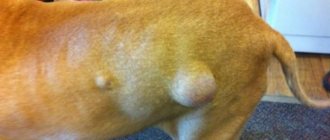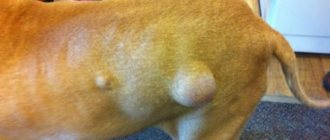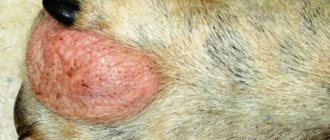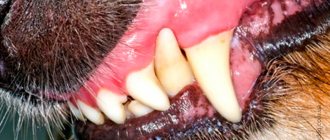Alena Igorevna Goncharenko
veterinarian Petstory
Finding a lump in a dog is always a cause for concern for the owner. If you notice any lumps on your animal’s body, you should be examined by a veterinarian as soon as possible. Delaying the diagnosis can negatively affect treatment, since many formations only increase over time and grow into other organs.
Eczema
Eczema is an inflammation of the superficial layer of the skin. It can be dry or weeping, focal (limited) or diffuse (scattered).
It begins with redness, the formation of compacted elevations (papules), turning into bubbles with liquid (vesicles). The vesicular exudate then becomes purulent and bursts, infecting the surrounding surface and causing maceration.
CAUSES:
- poor skin and coat care;
- use of unsuitable cleaning products;
- ectoparasites - lice, ticks, fleas;
- mechanical impact - rubbing the skin with a collar, muzzle, harness;
- chemicals - medicines, disinfectants.
Treatment of cones in dogs
Treatment will always depend on the type of formation. Most cases are benign tumors
do not require treatment.
Histiocytomas
go away on their own within a month.
Lipomas
can grow to quite large sizes and make it difficult for your pet to walk, lie down, and generally move around.
If the lipoma grows quickly, it is better to remove it. Papillomas and adenomas
do not increase in size and quite rarely interfere in any way. In some places on the body, they may be subject to constant trauma, causing them to become infected and bleed, in which case it is better to remove them.
Treatment of malignant tumors
depends on many factors and is selected individually by the oncologist. The type and size of the tumor, its location, the stage of the oncological process, and the presence of metastases are taken into account. Surgical excision of the formation, chemotherapy, and radiation therapy can be used.
Treatment of abscesses
consists of clearing the cavity of pus, installing drains to drain the resulting fluid from the cavity, and using antimicrobial drugs locally and systemically.
Allergic reactions
are treated with antihistamines and, if necessary, hormonal medications.
Hernias
can only be treated surgically.
Contrary to popular belief, no folk remedies can help with hernias; without surgery, it is impossible to set the organs in the right place and sutured the hernia ring. Enlarged lymph nodes
are only a symptom of some pathological process in the body; it is necessary to find out the cause and direct treatment to it.
Neoplasms
Tumors in dogs can be benign or malignant. It is very important to carry out correct diagnosis in a timely manner.
Benign
Benign cells retain the ability to differentiate, grow slowly, and never grow into surrounding tissues.
THE MOST COMMON BENIGN NEOPLASMS:
- Lipoma - a wen - is of soft consistency, painless, and easily movable. Develops in subcutaneous fatty tissue.
- Fibroma - can cause a feeling of fullness and aching pain. Occurs on the skin and mucous membranes.
- Adenoma is a growth of glandular epithelium. In older dogs it often appears in the perianal area. Associated with hormonal imbalance and increased androgen levels.
- Papilloma is a growth of the epidermis that occurs in aging animals. The main localization is paws, eyelids, head.
Malignant
They are formed from uncontrollably dividing cells and are characterized by a lack of cell differentiation, germination into adjacent areas, and metastasis to distant organs.
MOST COMMON:
- melanoma;
- carcinoma;
- sarcoma.
Diagnostics
Diagnosis begins with collecting anamnesis, finding out when the lump first appeared and how quickly it grew. Next, the pet is carefully examined, the formations are probed for density, mobility, and pain for the animal. Superficial lymph nodes are also palpable. The cytological diagnostic method is often used. Using a needle and syringe, cells are sucked out of the formation, which are then placed on a glass slide. The material is stained and carefully examined under a microscope. Cytology can usually make a preliminary diagnosis. In many cases, a biopsy and histological examination are necessary to make a final diagnosis. This procedure is more complex and takes more time to obtain results. If your pet is scheduled to undergo surgery to remove a tumor, your doctor may recommend magnetic resonance imaging.
Hernias
Hernia is the prolapse of the omentum, uterus, or part of the intestine under the skin. When internal organs prolapse through the umbilical ring - an umbilical hernia, through the inguinal canal - an inguinal hernia. It can be congenital or acquired, infringed or not infringed.
Outwardly it looks like a protrusion in the navel or groin area. Can reach significant sizes.
Congenital umbilical lesions are common in puppies and are sometimes treated conservatively.
Infringement of the uterus or intestines by a hernial ring is fraught with peritonitis and sepsis and requires immediate surgical intervention.
It would be a mistake to believe that only malignant tumors pose a danger to the life of an animal. No less serious, for example, are abscess and phlegmon, often leading to death.
Any skin seal requires careful diagnosis and proper treatment. Only a veterinarian can diagnose the disease and determine the tactics for its management.
In what cases should you immediately contact a veterinarian?
If any bumps appear on your dog’s body, this is a reason to consult a doctor to have them examined. You shouldn’t delay your visit and hope that they will go away on their own. If the tumor is benign, you can breathe out and not worry about the health of your pet. Early detection of a malignant tumor will give a good chance of a positive treatment outcome. If a malignant tumor is detected in the last stages, most often nothing can be done; the doctor prescribes only supportive treatment.
Treatment of an abscess must begin immediately after detection; delaying a visit to a doctor can lead to blood poisoning. Allergic reactions also need to be stopped immediately, without waiting for swelling of the larynx. A strangulated hernia is subject to emergency surgery before tissue necrosis begins. A non-strangulated hernia is treated as planned, but if it persists, emergency surgery may be required at any time.
What to do if detected
When you see a lump on your dog’s skin, you need to carefully examine it and carefully palpate it. If there is pain, you should immediately show your pet to a specialist, since the pathology can be dangerous due to suppuration, spread of infection, and malignancy.
A visit to the veterinarian cannot be postponed. Special tests may be needed to confirm the diagnosis:
- tomography;
- biopsy;
- X-ray examination;
- smear;
- radiography.
Only after this the treatment tactics are determined. Depending on the pathology, these may be conservative methods or surgical intervention. Under no circumstances allow your dog to chew, scratch, or lick the bump. Because of this, there may be granulomas, infection, and bleeding.
Take care of your pets, examine, stroke, feel. With enough attention, you can always detect any disease in the early stages and consult a specialist in time. Timely treatment will help avoid unpleasant consequences.
Recommended Posts
What to do if your dog is losing hair: 15 possible reasons
Symptoms and treatment options for arthritis and related joint diseases in dogs
How to Recognize Symptoms and Provide Treatment for Gastritis in Dogs
Review of 15 Dangerous Eye Diseases in Dogs
Causes of white feces in dogs and other abnormalities
History of the breed and main varieties of Spitz dogs
General symptoms
Typically, subcutaneous bumps do not bother dogs in any way, even if they are in the active growth phase. Depending on the cause of origin, spherical seals can have different densities and diameters - from several millimeters to several centimeters. Skin irritation and itching usually occurs with insect bites. In other cases, the lump can only be detected tactilely. In short-haired breeds, “defects” are noticeable visually, but in long-haired breeds they are diagnosed only by palpation.
If the appearance of the lump is suspicious, and the ball under the skin does not resolve within 7-10 days, then the dog must be shown to a veterinarian. The following symptoms may alert the animal owner:
- The dog reacts painfully to palpation of the lump.
- The lump “grows” before our eyes, increasing in size several times in a short time.
- The subcutaneous tissue is opened, and pus or other discharge begins to ooze from the wound.
- The color of the skin around the lump changes.
- The pet becomes apathetic, eats poorly or refuses to eat at all, and sleeps anxiously.
Main symptoms
There is no single clinical picture for bumps on a dog’s body, since they can be caused by different diseases, each of which has its own characteristic signs.
So, with an abscess that occurs under the influence of a bacterial infection that enters the body through a bite, puncture wound or scratch, the dog experiences swelling, fever, and pain. The lump swells for several days, after which it begins to fester.
Smooth-haired dogs often develop papillomas and warts on their bodies. The cause of their occurrence is considered to be a viral infection. The growths on the skin are usually brown in color and are painless, but it is still worth consulting a veterinarian.
The dog may develop a hematoma as a result of bruises or fluid accumulation when blood vessels are damaged during surgery. It is a formation that changes the shape of the part of the body where it is located. It does not cause discomfort to the dog, however, if the hematoma does not go away for a long time, consultation with a specialist will also be required.
A cyst can appear anywhere: both on the body and on the dog’s face, for example, at the junction of the jaws. Upon inspection, it is quite easy to detect. It appears as reddish, painful abscesses that the dog tries to lick.
Pyoderma is a purulent inflammation of the skin in dogs, which is accompanied by a rash and papules. Swellings can form all over the body, paws, in folds of skin, and on the face.
Insect bites (bees, ticks and even mosquitoes) can cause painful swelling. The most dangerous bites are to the face and mouth.
There are two types of tumors in dogs: benign and malignant. Benign tumors grow slowly and, as a rule, do not cause discomfort to the dog. Unlike malignant tumors, they do not metastasize. However, this does not mean that they do not pose a danger to the health of the animal, since over time they can degenerate into cancer.
Malignant tumors appear as a result of cell mutation. Cancerous tumors are characterized by rapid growth, absence of symptoms at the initial stage, and metastases. Sometimes the bumps break through the skin and bleed. As the disease progresses, an increase in symptoms is observed.
Prevention
Unfortunately, there is no prevention for most tumors. The exact reasons for their appearance have not yet been established; it is believed that ultraviolet and ionizing radiation, poor ecology and other factors that are extremely difficult to exclude from a pet’s life play a role in their development. Breast tumors can be prevented. There are studies according to which females spayed before their first heat have a less than 0.05% chance of developing such a malignant tumor. Then, with each heat, this percentage increases. Castration after the age of two years does not reduce the risk of developing neoplasms. Also, eliminating the use of hormonal medications to stop estrus reduces the risk of developing cancer.
Abscesses can be prevented by avoiding self-walking and fights between dogs. It is impossible to predict the development of an allergic reaction to something. But if the allergen is known, then contact of the dog with it should be excluded. Hernias are often congenital, which cannot be prevented. But traumatic hernias can be avoided if you always keep an eye on your pet while walking.
What is the tail for?
Firstly, this “appendage” acts as a steering wheel and a gyroscope in one bottle. Simply put, it helps the dog maintain balance and maintain direction of movement. Take a close look at your pet at the moment when he runs - you will immediately see how actively the animal helps itself with its tail. This is especially pronounced during sharp turns, running in circles and other complex “maneuvers”.
The tail is also very important when swimming: it plays the role of a rudder , with which the dog chooses the direction of movement. The importance of the organ is especially clearly visible if you compare the “buoyancy” of an ordinary dog and a representative of a breed whose tails are docked. So, swimming is difficult for boxers. True, in recent years, tails have been docked less and less, so that dogs are not deprived of an important organ.
Secondly, this part of the body plays an important role in transmitting odors . Experienced breeders know that there are paraanal glands on the loin of any dog. Their main purpose is to release a special lubricant that helps the animal during the act of defecation.
Their other function is the release of special odorous substances that serve the purpose of “non-verbal communication”. By the way, it is precisely for the sake of spreading this smell that self-confident dogs actively wag their tails when meeting their relatives. Finally, “scents” serve as a “passport” for dogs: by their characteristics, other animals learn about the age and social status of their opponent.
On the contrary, if the dog is frightened by something or is very unsure of himself, he diligently tucks his tail under his stomach . So the animal diligently tries not to attract undue attention to itself. But! Similar signs can also be seen in pets suffering from inflammation of the anal glands (also called sinuses). This pathology is very painful and can lead to serious consequences, and therefore we recommend that you immediately consult a veterinarian.
Causes of subcutaneous formations
Lumps under a dog's skin are not always associated with cancer. Most of them occur for the following reasons:
- Insect bites
. Swelling on the nose often remains after an unsuccessful encounter with bees. Their bites are always accompanied by redness and swelling.
- Mechanical injury
. After an unsuccessful jump for the ball and a not at all soft landing right into the wall, a bump may appear on the face of the unlucky pet.
- Infection
. With a weakened immune system, balls filled with pus often appear. This occurs due to infection by bacteria that cause inflammation. A virus can also cause compaction.
- Inflammation of the paraanal glands
. If a lump is found under a dog’s tail, then its appearance is affected by the inflammatory process. The affected area will be itchy and painful.
- Injection
. Swelling on the thigh or paw that occurs after vaccination is a natural reaction to the injected drug. After some time it goes away on its own.
- Tick infestation
. The attached parasite can be found on the stomach, side, chest, ear, chin and even under the eye. A mysterious growth that appeared shortly after a walk requires mandatory diagnosis. Some ticks carry deadly diseases.
Disorder of the functioning of the sebaceous glands and hair follicles. When the ducts are blocked, the secreted secretion accumulates inside the gland or follicle, leading to their growth.
The prolonged presence of swelling, accompanied by its increase and the appearance of pain, requires mandatory intervention by a veterinarian. Also, other alarming symptoms that are not directly related to education may be a reason for contacting.
Mechanical injuries to the tail
Dog tail injuries are an extremely large and very common group of pathologies. They are especially characteristic of animals with long and flexible tails. Dogs may well break them or get severely bruised by excessively expressing their emotions and violently waving their tail in all directions. As a rule, the very tip suffers, but there are cases when the organ breaks literally at the very base.
The problem is that the dog can constantly lick and even comb the affected area, which is why inflammation of an infectious nature is layered on top of the usual mechanical injury. That is why there are often situations when a dog loses its tail after receiving a seemingly insignificant injury.
In these cases, it is more the fault of the owners who did not bring their pet to the veterinarian on time, or did not follow even the basic recommendations of a specialist. If the tail is broken and severe purulent (or even necrotic) inflammation is observed at the site of injury, it is recommended to immediately amputate the affected part of the body.
First aid and treatment at home
Minor injuries can be treated at home (but we would still recommend having your dog examined by a veterinarian).
- First you need to “clean” the affected area , carefully removing all hair and dirt that interfere with normal access to the wound.
- Examine it carefully : if bones or their fragments are clearly visible in the thickness of the wound canal, further “amateur activities” should be stopped immediately and immediately seek help from a veterinarian.
- If you see that nothing serious has happened to your pet, further treatment is carried out in the same manner as already described above.
- In case of severe damage to the caudal vertebrae, the affected part of the body is simply amputated; in other cases, they are limited to applying a plaster cast or simply a tight bandage. The vertebrae of the tail fuse quite quickly, so there are no special problems.
Anti-inflammatory corticosteroids can be prescribed to relieve swelling and relieve inflammation. To speed up bone fusion, you need to feed your dog a balanced diet containing all micro- and macroelements, as well as vitamins. During this period, we strongly recommend reducing the number and duration of walks: the less the dog moves its tail, the faster it will heal. If signs of inflammation develop, antibiotics will be prescribed in addition to corticosteroids.











